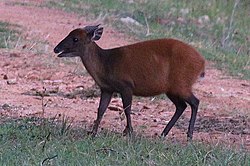| Weyns duiker | |
|---|---|
 | |
| Scientific classification | |
| Kingdom: | Animalia |
| Phylum: | Chordata |
| Class: | Mammalia |
| Order: | Artiodactyla |
| Family: | Bovidae |
| Genus: | Cephalophus |
| Species: | C. weynsi |
| Binomial name | |
| Cephalophus weynsi Thomas, 1901 | |
 | |
| Distribution of Weyns's duiker | |
Weyns's duiker (Cephalophus weynsi) is a tiny antelope found in the Democratic Republic of Congo, Uganda, Central African Republic and western Kenya. It is sometimes spelled "Weyn's", "Weyns", or "Weyns'" duiker.
Weyns's duikers average about 33 lb (15 kg) in weight when full grown, with a shoulder height of about 17 in (43 cm). They have plain rufous coats.
This duiker makes it home in lowlands and montane rainforests.
